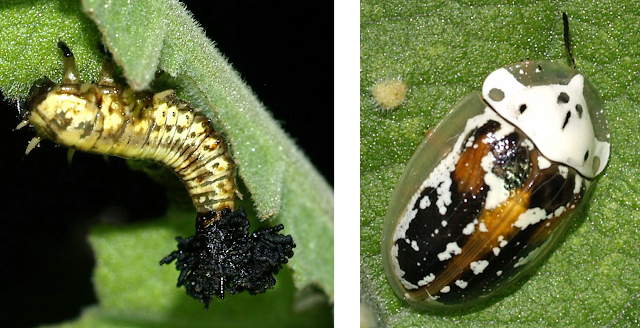Lower Sabino Canyon, so safe and easy to walk but usually too busy with visitors, changes character at night. A little more wilderness, a lot more mystery. Very few people. The air seems to vibrate with cricket and katydid sounds and some that are tantalizingly close and distinct like the solo of a percussion instrument in a jazz band, but unrecognizable - at least to my companion, reptile photographer Rene Clark, and me.
 |
| Migrating (?) Canyon Wrens were tucked under the eaves of all bath room buildings |
 |
| Crevice Spiders, Giant Crab Spiders, Flatties and Black Widows in abundance |
 |
| A camel cricket crossing the road |
On shear rock walls we looked for Amplygids (Tailless Whip Scorpions) but found only a very nice tarantula.
Ghostly pale beauties, Datura flowers lured me into the riparian underbrush. But it was the lowly Ragweed that bore interesting insects: the fecal-shield protected larva and the Halloween-masked adult form of the big tortoise beetle Physonota arizonae
At night, the nose can become become more important than the eyes. I never realized the fresh, fruity smell of blooming Brickell Bush and until now, and I had only smelled Desert Lavender after I crushed the leaves. Yellow asteraceae along the water exuded a potent tagetes smell that instantly conjured up my mother's garden's marigold borders. Most of the active responders were nectaring moths.
The Desert Broom also had a faint, pleasant smell that I noticed for the first time. Surprisingly, this time it did not make me sneeze. A rather mixed community here, even a canyon frog that remenbered its phylogenetic roots among the tree frogs
We also found many paper wasps of at least 3 species. They nearly all turned out to be sleeping males that drowsily, but harmlessly crawled towards the cameras and onto our sleeves.
Other insects relied on the warning the olfactory sense can provide: disturbed Pinacate Beetles interrupted their wandering and to stick their hind end into the air and when that wasn't enough to deter my probing finger I got doused with a staining, stinking gush of hydroquinons.
After renewing that experience I did not even try to interrupt the hurried pass of a Chlaenius ground beetle because I like their stench even less. And there was always the resident skunk rustling in the brush near by ...
 |
| Smerinthus saliceti |
 |
| Sphinx chersis, the Great Ash Sphinx |
 |
| Just then my camera died |
The rest of the way was uneventful but good exercise. To tired to ponder why the mantis crossed the road. Home by midnight. A night well-spent.













I didn't realize that it was open late. I always thought it closed at sun down. I will have to try and go in the evening sometime. So many visitors during the day!
ReplyDeleteIt's very worth staying up late for!
DeleteOh my, you find some wonderful insects .... and I love the painting.
ReplyDeleteI just found this blog and have high hopes for it to continue. Keep up the great work, its hard to find good ones. I have added to my favorites. Thank You.
ReplyDeleteShower Faucets